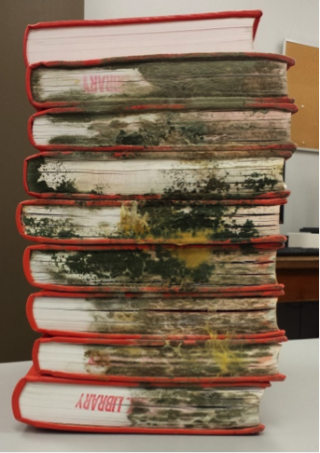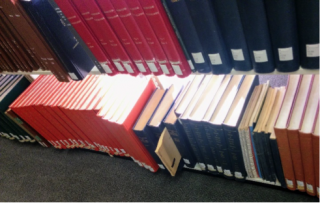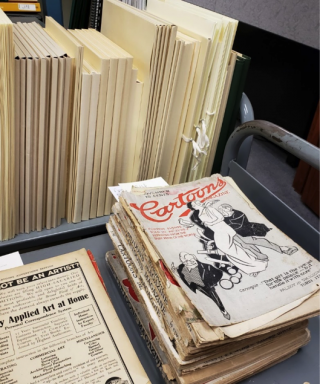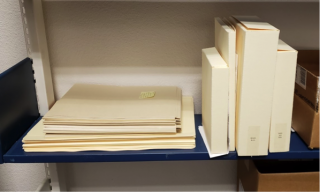Earth Day inspires awareness of nature and inspires action. A day dedicated to honoring the Earth sparks thoughts on what steps we can take, personally and in the workplace, to preserve and protect the essentials for life. There are numerous ways to positively impact the environment—a list of just a few things to do: plant a tree, use recycled paper, switch to LED bulbs, buy local, use less energy, reduce consumption, and avoid single-use plastics.
The Preservation unit is relatively new to the Libraries and as it grows, we are interested in leaving a smaller environmental footprint. Focusing on what we can do at work to have positive impact on nature leads to thoughts on how the Libraries Preservation unit can implement environmental and sustainable initiatives.
But first, what is preservation? As defined by the American Institute of Conservation, it’s “The protection of cultural property through activities that minimize chemical and physical deterioration and damage and that prevent loss of informational content. The primary goal of preservation is to prolong the existence of cultural property.” In other words…
- Proper care and handling
- Environmental control (temperature and relative humidity)
- Creating paper-based enclosures to house items
- Pest management
- Emergency prevention and protection
- Security of the facility and the collections
- Physical or chemical stabilization
- Reformatting (photocopying, microfilming, digitization)
- Digital preservation
Prolonging the existence of cultural property—the end goal of preservation activities—is environmentally friendly. The above activities ensure that collections will last well into the future; longevity and proper care mean that replacing materials won’t be necessary, for a long while at least. It is a sustainable practice to maintain collections and “reuse” cultural materials, keeping them accessible and usable.
Mold and sunlight on books – not preservation.
However, a closer look at preservation with a sustainability perspective reveals more than just the end goal. The initial steps and behind-the-scenes activities of proper preservation are numerous, and require energy, supplies, vendors, and planning. There are many challenges in the “how” of preservation; the below sampling of preservation requirements are followed by questions that ask how those requirements can be fulfilled.
| Preservation requirements | Questions |
| Building temperature between 65-70°F, relative humidity < 50% | How much energy needed to keep building at correct levels 24/7/365? Is energy source using fossil fuels? Is there a way to reduce energy consumption? |
| No direct sunlight on materials | How can interiors be rearranged to work with the building design/window placement? Are there blinds or UV film for windows? |
| UV and infrared light exposure on materials should be limited/controlled | What workarounds are there for exhibiting light-sensitive materials? What is the cost of protective UV sleeves for lights, special lighting, etc.? Is there room to relocate materials that are shelved too close to lighting in the ceiling? |
| House fragile or brittle items in paper-based and plastic enclosures | Can less waste be produced to start with? How can paper scraps generated from creating custom protective enclosures be reused? Are there local suppliers of archival material that don’t require orders to be shipped over long distances? What kind of “green” archival supplies exist? |
| Keep pests (e.g., insects, rodents, etc.) out of the building | How harmful to humans and to the environment are the chemicals used for pest control? |
| Prevent airborne pollutants from reaching items | Is the building airtight and equipped with proper filtration system(s)? Are filters changed regularly? Are stacks and storage areas regularly cleaned or dusted? |
| Have a plan for responding to emergency situations (e.g., floods, fire) that affect collections | Was emergency a result of weather? Did proper cleanup or repair take place to the building to prevent any further damage? What role did climate change play in duration or frequency of event? Will these events increase in the future? |
| Assess items that have been added to the collections | Will the items need to be cleaned? What is their condition? How many enclosures will be needed to properly house the items? |
| Digital preservation | How much magnetic media will be left behind once items are digitized? How much electricity is used to store digital files on servers? Where does e-waste go? |
Obviously, numerous challenges exist with the activities that lead to properly preserved materials. If the goal is to leave a positive impact on the environment, we need to find solutions for these challenges. Two of the biggest issues are energy consumption by the building for climate and pollutant control, and protective enclosures. (Note: digital preservation is another big issue—too big to include in this post.)
The climate requirements (temperature and humidity) of a building can’t be changed much when preservation is in mind. Higher temperatures and higher relative humidity, along with large fluctuations in both (instead of a stable climate), can cause materials to degrade at a faster rate. Some practical solutions are worth considering. During building renovations there are opportunities to reevaluate and/or upgrade climate control equipment for efficiency during low load times, and design planning can focus on things like keeping spaces occupied by humans separate from storage areas and reducing fan energy by redesigning ducts. Opportunities for operational savings can also be explored; this might include monitoring the space with data loggers to identify areas where it’s safe to use less energy, and not heating storage spaces to temperatures comfortable for people in the winter. But ultimately, energy consumption will remain a constant need, and with the reality of climate change, consumption will likely increase.
The supplies used to create preservation enclosures have specific requirements to make them suitable for long-term storage of materials. Paper and paper-board products must be acid-free, lignin-free, and in some cases buffered (alkaline, pH 8-9). Although the enclosures will absorb acid from air and from the materials they protect over time, they still act as an important barrier to handling, light, and dust. Plastics are also used for storing materials (often photographs), and only mylar, polypropylene, and polyethylene should be used. Although these can be seen as single-use plastics, they’re at least being used for long periods of time.
Example of paper-based enclosures in background, and items needing protective enclosures in foreground.
The lack of “green” alternatives to these enclosure types means supplies made out of recycled materials can’t be used and consumption of special paper can’t be reduced; additionally, local sources aren’t typically available for these supplies, meaning that shipping is required. The best approach to paper supplies may be to reduce, reuse, and recycle, making sure to exhaust all reduction and reuse options before recycling. For example, reduce the amount of waste produced when making enclosures by maximizing surface area, reuse any paper, folders, or boxes that remain in good to fair condition, and recycle by partnering with another department that may be able to use paper scraps.
Pre-loved enclosures waiting to be reused.
In light of the challenges realized, sustainable initiatives may be more difficult for the Libraries Preservation unit to act upon, but small steps with the building and supplies are a start. We’re interested in addressing these issues consistently, and reevaluating our progress every Earth Day.
For more information:
Jones, Ashley. 2013. “Sustainability in Library Preservation.”Technical Services Quarterly, 31:1, 31-43, DOI: 10.1080/07317131.2014.844631.
Reilly, James. 2008. “Specifying Storage Environments in Libraries and Archives.” From Gray Areas to Green Areas: Developing Sustainable Practices in Preservation Environments, 2007, Symposium Proceedings. Accessed April 20, 2018. https://www.ischool.utexas.edu/kilgarlin/gaga/proceedings2008/GAGA07-reilly.pdf
Verheyen, Peter D. 2013. “Archival 101 & Working with Suppliers of Archival Products.” ALCTS Webinar on April 25, 2013. http://downloads.alcts.ala.org/ce/04252013_Archival%20101.pdf




